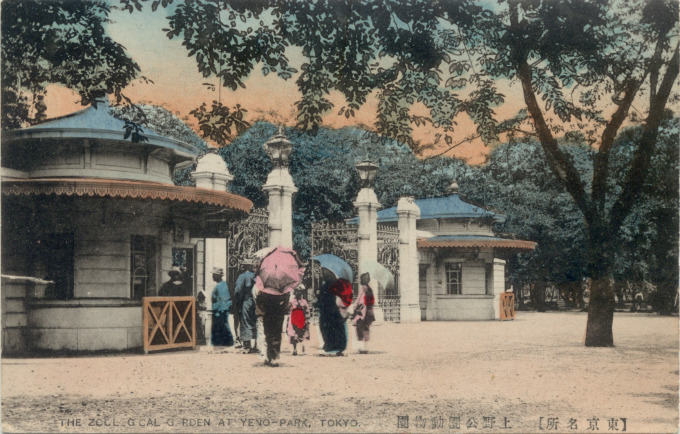See also:
Ueno Park, c. 1910
Ueno Pank Museums, c. 1910
Elephants at Ueno Zoo, Tokyo, c. 1950.
Established in 1882, Ueno Zoo is the oldest zoo in Japan. The zoo is in Ueno Park, a large urban park that is home to museums, a small amusement park, and other attractions. The ground was originally estate of the imperial family, but was bestowed to the municipal government in 1924 — along with Ueno Park — on the occasion of crown prince Hirohito’s wedding.
“A prominent journalist on wartime history, Takamiya Tahei, writes that schoolchildren were whispering to each other in October 1943 . ‘I hear the lions were killed at Ueno Zoo.’ ‘So were bears and tigers.’ ‘Elephants might have been killed, too.’ ‘Enemy spies killed them.’
“Governor-General Odachi decided to destroy the ferocious animals at Ueno Zoo after much deliberation for a person who was known for his quick decision making. He made the decision carefully because he was concerned with the possible negative reactions to the disposal by citizens, especially by children who enjoyed watching these ferocious animals at Ueno Zoo.
“Feeding these carnivores was not easy when people were desperately looking for their own food. However, the feed shortage was not the problem for Odachi. His concern was the escape of these animals should their cages be destroyed by air raids … Anticipating a public outcry for such extreme measures, Governor-General Odachi had Ueno Zoo destroy its animals with strict confidentiality and kept it from the press.”
– Japanese Wartime Zoo Policy: The Silent Victims of World War II, Mayumi Itoh, 2010
Between August 17 and September 11, 1943, grieving zoo staff were ordered to kill the more than twenty captive zoo carnivores and herbivores at Ueno Zoo. The zoo’s most beloved residents, three Asian elephants, suffered most of all, finally succumbing after weeks of painful and bewildering starvation.
In post-war Tokyo, children wanted an elephant so much that they wrote to Prime Minister Jawaharlal Nehru of India for one. Their wishes were granted, and in 1949 Nehru sent a female elephant to the children of Japan. Named Indira after his daughter, the 15-year old elephant arrived at Ueno Zoo, her permanent residence, on September 25, 1949.





Pingback: Ueno Park, c. 1910. | Old Tokyo
Pingback: Elephants at Ueno Zoo, Tokyo, c. 1950. | Old TokyoOld Tokyo
Pingback: Hakubutsu-kan (National Museum), Ueno Park, Tokyo, c. 1910. | Old TokyoOld Tokyo